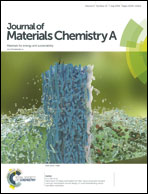Sulfur dioxide gas-sensitive materials based on zeolitic imidazolate framework-derived carbon nanotubes†
Abstract
Novel sensing materials that combine high sensitivity and selectivity as well as proper working temperature are essential for advanced gas detection applications. Metal organic framework (MOF)-based materials are promising candidates for many applications including gas sensing, but they exhibit some limitations such as a low electrical conductivity and high operating temperature, which have to be overcome. Herein, we demonstrate the synthesis of gas-sensing materials for sulfur dioxide, namely, carbon nanotube networks based on zinc-doped zeolitic imidazolate frameworks (ZIF-67) (bimetallic MOFs). The particles synthesized via bimetal co-doping of cobalt and zinc and the pyrolysis process possess a porous polyhedral morphology with abundant interconnecting carbon nanotubes (CNTs) on the surface, which results in significant sensitivity, cross-selectivity and durability towards SO2 at room temperature. This approach combines the advantages of both MOFs and CNTs. First-principles calculations further elucidate that the doped zinc embedding on the nanotube changes the SO2 adsorption level to a narrow p accepting level, which increases the hole carrier concentration remarkably and subsequently improves the conductivity to a large extent, thus providing excellent sensing performance with respect to the target gas.



 Please wait while we load your content...
Please wait while we load your content...